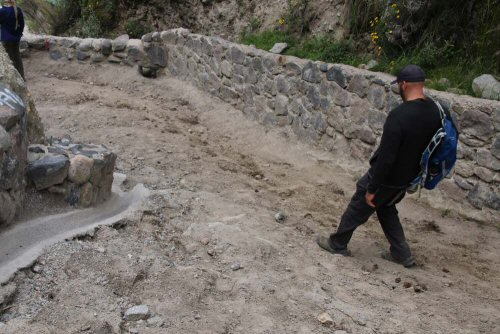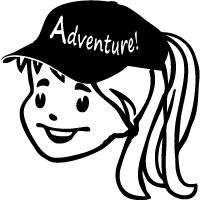 Adventuriety / Domesticiety
Adventuriety / Domesticiety
There were three main reasons for visiting Quito on our South American trip. First, Daisy had a desire to see the Galapagos Islands which are Ecuadorian territory and accessible through the Quito airport. Second, my father thought it wouldn’t be a bad place to spend some time. He enjoyed Quito in the 80’s and used the surrounding mountains and volcanoes like Cotopaxi to train for his assents up Aconcagua. Knowing how we like to travel and that we were into acquiring more of the Spanish language, he thought Quito might be a good stop. Third, I was intrigued by Quito after watching Anthony Bourdain’s “No Reservations” Ecuador edition. He is skilled at making just about anywhere look good (although I hear he botched the show on New Mexico) and the sights and sounds presented in his show were appealing.
The academic year for Grant and Ashley is winding down and as a result we needed to choose a place to spend nonactive days so that we could stay ahead and ensure the ability to study for finals. The result of these parameters was the decision to stay in Quito for 11 nights between Peru and visiting the Galapagos. Our first day consisted of priming our apartment for the stay, washing the Peru out of our clothing and arranging for Daisy to travel home temporarily to be by her brother’s side after an unexpected surgery. We had a nice evening walk in the Parque De Carolina before she left for the airport. It was a major downer for her to go and although she might not miss the days of school work, she would not be along for the three guided excursions we had planned or random evenings out.
Today’s adventure to an indigenous market, art studio and volcanic lake crater left the three of us with mixed feelings. Most of my thoughts about the day were critical and when I shared what we did with Daisy she heard more complaints than praises.
Primarily, we spent too much time in the car. Long stents in a vehicle can be enjoyable especially when traveling from A to B and the day can end with a sense of accomplishment. An out-and-back trip of seven hours however was a bit too much especially because 3 of those hours were located within the Quito urban zone of 2.6 million. A return trip of this length had better have something spectacular at the end. I would personally travel that length for a day of windsurfing and my father would for skiing. Today, however, was short of spectacular.
Our first stop was at an indigenous market that had evolved only slightly over the past few hundred years. The trade is similar as it has been for centuries. People bring things from the coast, the jungle and the highlands to buy, sell or trade. For us, the experience was most interesting considering the variety of fruits and vegetables that were completely new to our eyes and taste buds. Our first experiment was with the Taxo fruit which is indigenous to New Zealand but is popular and grows well in Ecuador.
Our mouths spent a few minutes on the learning curve of how to manage the pulp-seed separation and tried to figure out how the taste was different than Emergen-C or AirBorne vitamins. As surprising as the taste was, we did not expect to see what was presented when the fruit was split open. Many little seeds coated in an orange gelatinous substance. Next we tried Achotillo which did not appear at all to be edible. This thick-haired red koosh ball looking item resembling something that may have been developed as a prop for some Star Trek episode. You can dig your thumbs in and with some pressure separate the furry shell from the inner edible centerpiece. The inside is a rather large seed surrounded by a clear body reminiscent , in texture and even taste, a white grape.
Finally, we took some nibbles out of an item that had a name I had forgotten and a taste and texture I was happy to forget as well. Here is a picture of the stuff and if any reader wants to comment on what it is, please feel free.
Although the market was interesting, and we took many pictures of edibles previously unknown to us, it was missing two things. Our Peruvian guides were very knowledge and answered with certainty just about every question we (I) could think to ask. Our Ecuadorian guide is a kind man with a five-year-old and a baby on the way. He seems a bit distracted by this and also, though qualified on the trail, he does not have much cultural or historical knowledge to share which is okay.
We really missed the friction that Daisy creates. Have you ever tried to ride an exercise bike that has no resistance on the wheels? If you have not, it is an unnatural feeling. It is similar too, to picking up an assumed to be filled vessel that is actually void of the quantity of fluid you expected only to nearly throw the thing through the roof. Resistance is important in some things and on our excursion to the market there was none and we missed it. When presented with unwashed fruit that had been sitting in an open air market around a variety of products in differing states of decay, Daisy would have surely said first “I’m not eating that,” followed by “You guys are not eating that.” Then we would proceed to have some discussion and some fraction of our group would end up, in a more heightened state, trying the fruit. This is the missing resistance. Daisy’s caution and hesitance is a catalyst for a more exciting experience. Her words have the effect of the “click,” “click,” “click” near the top of a roller coaster which heightens the experience. We just approached the hot unwashed fruit tasting experience like “what the hell” followed by “tastes interesting.”
Our next stop was a roadside art gallery where a dear, older Ecuadorian man with indigenous roots and a four and a half foot frame, created wooden masks, paintings and had a variety of other tourist trap type things to sell. He had many 5×7 canvases on the wall that were all really nice and a joy to look through. I asked him which one was his favorite. He understood my question in Spanish and replied in Spanish of which I understood 60-70%. Good enough. He reminded me so much of my good neighbor Bernie as he told the tale of the painting. We looked at it together and he talked about a trip his parents took him on to the big city of Quito when he was a boy. He remembered that they bought him a new hat and poncho which he kept for many years along with a detailed memory of that day.
After another bit of driving we arrived at Quilitoa crater and lake. Quilitoa is a volcano that erupted catastrophically 800 years ago leaving a crater that has accumulated a lake of greenish mineral filled water due to remaining hot springs. There are gases still being emitted from cracks at the bottom of the lake resulting in bubbles near the shore. Finally, after 4 hours of traveling and sightseeing we were able to take a hike. We started at the crater top and then descended quickly down the steep and loose trail. We descended 900 feet in only about 15 minutes and then spent a short amount of time meandering about the shoreline. Our guide had some inaccurate facts about the source of the water and the age of the lake. You know how you can tell when someone is answering a question and it is balderdash? It really is a beautiful crater and it really is a beautiful lake, but our time spent there felt a bit empty. There was no historical or cultural context to learn or wonder about and the backup scientific facts were not available. Had there been mobile data, I would have enjoyed reading some wiki page right there on the spot. As it was, we were ready for a quick exit and the hike back to the rim.
Before we dropped into the crater, I was fairly sure my Spanish ears heard a wager forming about the number of minutes we would last coming back up. The trail was no cupcake. It was steep, loose and all above 12,000 feet. To add to the gamblers’ confidence, there are a dozen or so lakeside mules which are commonly rented to take people out of the crater, Ashley is only twelve and I am not the thinnest gringo. We were offered (strongly encouraged) by the mule hands not to try hiking out and our guide had mentioned the option enough that I could probably have harmonized with him. In response to all of this, I challenged the kids to climb out without a stop. We did just that. A steady pace onward but mostly upward. Our guide met us at the top, tired and ready for lunch.
So, yes, the lake was pretty. Yes, the success in getting up in such a pro way felt great. All in all though, the experience was not the same as having Daisy along. She wasn’t there to complain about the trail going down, or discuss the shape of the mules at the bottom or remind us to use additional sunscreen, etc. The missing resistance made for a lesser day.







